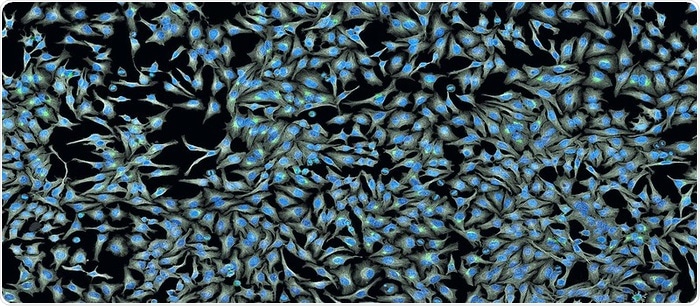In spite of the immense advances in medicine, tumors are hard to cure as they are made up of heterogeneous cells. Similar to families, the individual cells of a tumor share common characteristics and traits; however, as the tumor expands, the cells also establish their own identities.

This photograph shows a panoramic view of HeLa cells, a cell line many researchers use to study a large variety of important research questions. The cells’ nuclei containing the DNA are stained in blue and the cells’ cytoskeletons in gray. Image Credit: Tom Deerinck, National Center for Microscopy and Imaging Research.
This results in some cells being more resistant to therapy than others and more rapidly adapt and change.
A group of scientists from the University of Texas at Austin created a novel approach to tag tumor cells to identify how they evolve and change eventually to resist cancer treatments. They analyzed chronic lymphocytic leukemia (CLL) principally, and these findings helped scientists to know more about the entire spectrum of cancerous tumors.
This is a technology that lets you replay the evolutionary history of the tumor. We can collect those pre-resistant cells and go back and look at what happened to them. We can try many parallel treatments and measure how specific cells respond and which ones persist.”
Amy Brock, Study Co-Lead Author and Associate Professor, Department of Biomedical Engineering, Cockrell School, The University of Texas at Austin
The study has been published in the journal Nature Cancer.
The capability to essentially “tag” nucleic acids—the genetic information of the cell, like RNA or DNA—to oversee them is not a brand-new technology. But present capabilities do not provide a full picture of how tumor cells evolve.
The platform, named ClonMapper, can look backward and trace how tumor cells change over time. This provides scientists the opportunity to observe which cells “win out” over less resistant cells, proceed to clone themselves, and make the tumor more hazardous. Isolation of cells can help scientists better test which treatments do not and do work against them.
Observing changes over time is the main essence of successful transfer treatments. Tumor cells adjust to treatments and become resistant. This is the reason why patients can go into remission but later experience relapse.
This is one of the reasons cancer treatment is so challenging—we don't have very good ways of predicting ahead of time which cells will be sensitive to a type of drug and which ones will be resistant. This acquired resistance is a leading cause of treatment failure for many patients with cancer.”
Amy Brock, Study Co-Lead Author and Associate Professor, Department of Biomedical Engineering, Cockrell School, The University of Texas at Austin
CLL is a low-grade B-cell malignancy that is often observed for months or even years before it requires active treatment. This “watch and wait” style of treatment depends heavily on the accurate observation of the patient.
In the current research, ClonMapper concentrated on pinpointing which cells were cloning themselves, and how rapidly the process happens, as well as its influences on the growth rate of surrounding cells over time. This permitted a much more precise analysis of the cell population and may facilitate more customized treatment plans for patients.
The ClonMapper research was headed by scientists from UT Austin and the Dana-Farber Cancer Institute, Harvard Medical School, and the Broad Institute. The UT Austin research team included from the Cockrell School and College of Natural Sciences Aziz M. Al’Khafaji, Eric Brenner, Kaitlyn E. Johnson, and Russell E. Durrett.
The UT Austin researchers are now employing ClonMapper to analyze various kinds of cancer. Brock’s laboratory recently received funding from the National Cancer Institute to perform research on breast cancer and has an ongoing association with Dell Medical School working on colorectal carcinoma treatments.
Source:
Journal reference:
Gutierrez, C., et al. (2021) Multifunctional barcoding with ClonMapper enables high-resolution study of clonal dynamics during tumor evolution and treatment. Nature Cancer. doi.org/10.1038/s43018-021-00222-8.